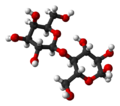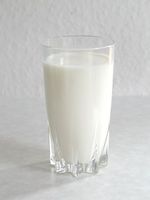Lactose
| Lactose | |
|---|---|

| |
| General | |
| Systematic name | 4-O-β-D-galactopyranosyl-D-glucose |
| Other names | Milk sugar |
| Molecular formula | C12H22O11 |
| SMILES |
C([C@@H]1[C@@H]([C@@H] |
| Molar mass | Molar mass::342.3 g/mol |
| Appearance | white solid |
| CAS number | CAS number::5989-81-1 |
| Properties | |
| Density and phase | Density:: 1.52 g/cm³ |
| Solubility in water | 21.6 g/100 ml |
| Melting point | Melting point::202.8°C |
| Boiling point | Boiling point::668.9°C |
| Viscosity | 15% cP at 10-50°C |
| Structure | |
| Crystal structure | rhombohedral |
| Hazards | |
| MSDS | Material safety data sheet |
| Main hazards | Irritant |
| NFPA 704 | |
| Flash point | 357.8 °C; 676.0 °F; 631.0 K°C |
| R/S statement | R: Lactose is not very dangerous. Can cause is irritation to the skin or eyes. S: If irritated wash with soap and cold water. |
| RTECS number | OD9625000 |
| Related compounds | |
| Other anions | Glucose |
| Other cations | galactose |
| Related compounds | sucrose |
| Except where noted otherwise, data are given for materials in their standard state (at 25 °C, 100 kPa) Disclaimer and references | |
Lactose is the main carbohydrate in milk of many mammalian species, and thus a common chemical in most dairy products. Its physical properties are white, hard, and it is a crystalline mass of powder. It is composed of glucose and galactose. Lactose is limited on the market and not likely of strong expansion, the best thing to do is to process the solids to make better products.
Lactose has many uses in the world. It can be used as sweeteners, yogurt, seasonings, and dry mixes because it remains free flowing in high humidity and temperature. It is also a major ingredient in milk. There are many ways lactose can be used in the world. However some people cannot have lactose. This is known as lactose intolerance. Lactose intolerance is when the body is unable to easily digest lactose. It is not considered a food allergy. There are many facts about lactose which are covered in this paper.
Properties
Lactose is the main carbohydrate in milk of many mammalian species. It is composed of glucose and galactose which are linked by bonds made of β1→4 glycosidic. Lactose concentration is between 0 and 10%. Milk is the most significant source of lactose known. [1] Lactose is actually less soluble in pure water and more soluble in molar solutions like calcium chloride or calcium nitrate. This is due to an increase in the concentration of salt in lactose. This is thought to be related to rotations of lactose in salt solutions.[2]
Lactose's physical properties are white, hard, and a crystalline mass of white powder. When it is dissolved in a serum it has two forms known as the A anomer and the B anomer. If a lactose crystal is formed below 70 degrees F, they are mainly A anomers. A anomers are very hard and firm. B anomers are sweeter and more soluble.[3]
Synthesis / Occurrences
During the filteration process for whey and milk it is important to develop commercial applications for the solids from milk and whey filteration streams. Lactose is the main substance in these streams. Also since lactose is limited on the market and not likely of strong expansion, the best thing to do is to process the solids to make better products. Another option is to chemically modify lactose to things like lactitol, lactulose, lactosyl urea, lactobionic acid, and gluconic acid. Using hydrolysis can form monosaccharides, glucose and galactose.
Uses
Lactose has many uses in the world. Some of them are in ways you might not even imagine! In bakery products lactose can be used as a browning agent to help develope color. It can also be used as sweeteners, yogurt, seasonings, and dry mixes because it remains free flowing in high humidity and temperature. Also in baked goods it can be used to develop flavor and control mold growth. [5]
In frosting and savory fillings it works to reduce sweetness. In dairy products like yogurt it improves the flavor. For coffee it helps provide volume. Dry mixes use it to prevent them from sticking together. Lactose is also in milk. Lactose has many uses in the world. [6]
Lactose Intolerance
Lactose intolerance is when the body is unable to easily digest lactose. It is not considered a food allergy, because your not allergic, you just can't digest it. Some people are unable to digest it completely, and others are able to have little amounts safely. It is common in native Americans and occurs in some Asian, African, and European people. The biggest challenge for lactose intolerant people is to get enough calcium without drinking any milk. [7]
Symptoms of lactose intolerance are abdominal pain, abdominal bloating, gas, diarrhea, and nausea. There are two common tests to determine whether someone is lactose intolerant. The hydrogen breath test is when a person drinks a lactose beverage and then analyzes your breath to check for hydrogen. If there are high levels of hydrogen then the person is more likely to be lactose intolerant. The stool acidity test is for infants. If high amounts of lactose are detected in a stool sample then they probably are lactose intolerant. [8]
References
- ↑ Fox, P.F. [1] Lactose: Chemistry and Properties. Web. Date-of-access January 2, 2014 .
- ↑ B.V, Elsevier.[2] Some Physico–Chemical Properties of Lactose: VI. The Solubility of Lactose in Salt Solutions; The Isolation of a Compound of Lactose and Calcium Chloride. Web. Date-of-access January 2, 2014.
- ↑ O Brien, J. [3] Milk Carbohydrate (Lactose). Web. Date-of-access January 2, 2014.
- ↑ Zadow, J.G. [http://www.journalofdairyscience.org/article/S0022-0302(84)81625-2/abstract ] lactose: properties and uses. Web. Date-of-access January 13, 2014 (specify which).
- ↑ Unknown. [4] Functional Benefits of Lactose Products. Web. Date-of-access January 1, 2014 (specify which).
- ↑ Unknown. [5] Functional Benefits of Lactose Products. Web. Date-of-access January 1, 2014 (specify which).
- ↑ MD, Bethesda. [6] Lactose Intolerance - Topic Overview. Web. Date-of-access January 12, 2014 (specify which).
- ↑ MD, Bethesda. [7] Lactose intolerance. Web. Date-of-access January 4, 2014 (specify which).
| ||||||||||||||


